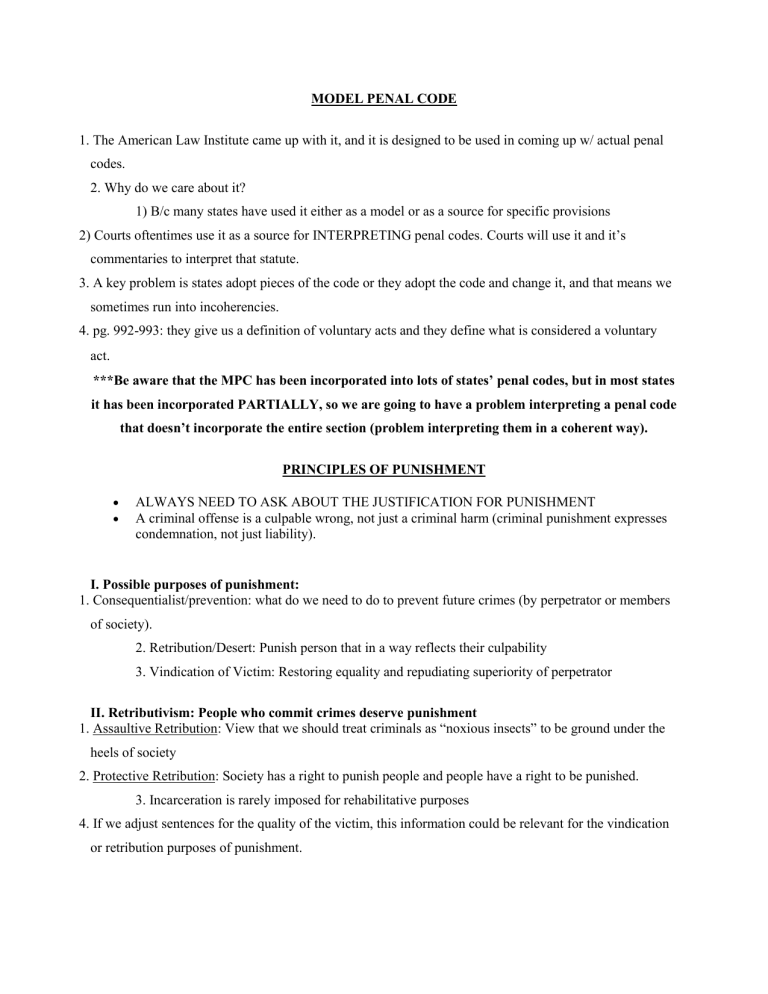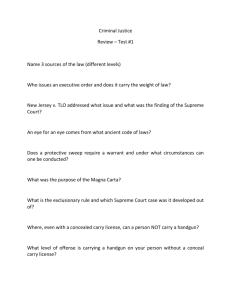
MODEL PENAL CODE 1. The American Law Institute came up with it, and it is designed to be used in coming up w/ actual penal codes. 2. Why do we care about it? 1) B/c many states have used it either as a model or as a source for specific provisions 2) Courts oftentimes use it as a source for INTERPRETING penal codes. Courts will use it and it’s commentaries to interpret that statute. 3. A key problem is states adopt pieces of the code or they adopt the code and change it, and that means we sometimes run into incoherencies. 4. pg. 992-993: they give us a definition of voluntary acts and they define what is considered a voluntary act. ***Be aware that the MPC has been incorporated into lots of states’ penal codes, but in most states it has been incorporated PARTIALLY, so we are going to have a problem interpreting a penal code that doesn’t incorporate the entire section (problem interpreting them in a coherent way). PRINCIPLES OF PUNISHMENT ALWAYS NEED TO ASK ABOUT THE JUSTIFICATION FOR PUNISHMENT A criminal offense is a culpable wrong, not just a criminal harm (criminal punishment expresses condemnation, not just liability). I. Possible purposes of punishment: 1. Consequentialist/prevention: what do we need to do to prevent future crimes (by perpetrator or members of society). 2. Retribution/Desert: Punish person that in a way reflects their culpability 3. Vindication of Victim: Restoring equality and repudiating superiority of perpetrator II. Retributivism: People who commit crimes deserve punishment 1. Assaultive Retribution: View that we should treat criminals as “noxious insects” to be ground under the heels of society 2. Protective Retribution: Society has a right to punish people and people have a right to be punished. 3. Incarceration is rarely imposed for rehabilitative purposes 4. If we adjust sentences for the quality of the victim, this information could be relevant for the vindication or retribution purposes of punishment. III. Utilitarianism: Forward looking—based on benefits that will accrue from its imposition 1. Important principles of utilitarianism: 1) General Deterrence (Greater the temptation to commit crime, then greater the punishment) In general, an increase in the detection, arrest, and conviction rate is of greater deterrent consequence than an increase in the severity of the penalty upon conviction. 2) Individual Deterrence—Fear in offender that if he does act again, he will be punished again 3) Incapacitation and other forms of risk management (puts convicted criminals out of general circulation) 4) Reform 2. Cases where punishment ought not to be inflicted (pg. 35): 1) Groundless 2) Inefficacious 3) Unprofitable or too expensive 4) Needless IV. Mercy 1. Mercy actually involves a departure from justice b/c we treat them better than they have a claim to in justice. 2. Mercy doesn’t really fit w/ retribution, but it does fit in more w/ a consequentialist system. V. Repeat Offenses 1. Notice that when we have a repeat offender that is mean and callous, it seems easy to have a more severe punishment. But what happens if we have a situation where we have an offender that is a high risk, but is somehow less blameworthy? Think of a mentally retarded person w/ a history of violence. 1) Understand the relationship between culpability and prevention as a justification for more or less severe punishment (this relationship gets difficult in cases such as w/ a mentally retarded person). VI. Proportionality of Punishment 1. Coker v. Georgia: Court had to determine whether death penalty given for multiple rapes was considered excessive punishment. Majority of court found death penalty for rape was excessive punishment, citing that no deaths had occurred b/c of the rapes Minority opinion discusses how the question should more appropriately be punishment for this offense as committed by this individual w/ this particular history. Many offenses are defined in terms of harm caused, but what is the punishment supposed to be proportionate to? If it is the harm caused, then shouldn’t homicide, manslaughter, etc. all be the same punishment b/c there was a loss of life? 2. Is there any reason the death penalty should be limited to homicide? Could argue the punishment should only be there after the taking of a human life, but that seems to suggest the limit on proportionality is the harm done by the offense. Is that a plausible limit on proportionality? 3. If any of these victims had managed to slit his throat, would that have been a legal self-defense? If this is justified, then why wouldn’t a punishment of this magnitude be justified? Although self-defense and punishment are there to prevent crimes, there is something very different about them. ***There is a problem coming up w/ the punishment for proportionality requirements. VII. Summary of Punishment 1. Punishment vindicates the law and the standing of the victim. 2. The purpose is to prevent such criminal conduct in a way uniquely applicable to each circumstance (i.e. if someone is mentally impaired). 3. We have consequentalist purposes from punishment (deterrence), and we have retributive factors (punishment should fit the crime). 4. The notion of proportionality is deep in the area, but determining the proportionality to what is difficult to determine. ACTUS REUS I. Definition 1. Actus Reus: is to be interpreted as the comprehensive notion of act, harm, and its connecting link, causation, with actus expressing the voluntary physical movement in the sense of conduct and reus expressing the fact that this conduct results in a certain proscribed harm, i.e., that it “causes” an injury to the legal interest protected in that crime 2. Components of actus reus: 1) Conduct, 2) Circumstances, 3) Results, AND 4) Causation II. Voluntary Act 1. Martin v. State: Man was drunk and cops carried him out to the highway and then arrested him for being drunk on the highway. Court said no actus reus: Act wasn’t voluntary b/c cops carried him out to highway, and ACT MUST BE VOLUNTARY 2. MPC on pg. 993 defines acts that aren’t voluntary: 1) A reflex or convulsion 2) A bodily movement during unconsciousness or sleep 3) Conduct during hypnosis or resulting from hypnotic suggestion 4) A bodily movement that otherwise is not a product of the effort or determination of the actor, either conscious or habitual 3. Decina on pg. 128: Was found to be guilty b/c even though the seizure wasn’t voluntary, His voluntary act was earlier in the sequence (driving in the car when he knew he was at risk for getting a seizure). III. Omissions (“Negative Acts”)—Failures to Act 1. Situations where omission is a breach of a legal duty 1) Where a statute imposes a duty 2) Where one stands in a certain legal status relationship to another 3) Where one has assumed a contractual duty to care for another 4) Where one has voluntarily assumed the care of another and so secluded the helpless person as to prevent others from rendering aid 5) POSSIBLY THIS SITUATION: When a person creates a risk of harm to another 2. Ordinarily don’t have failure to report crime as a criminal offense 3. Barber v. Superior Court: Classifying cessation of treatment important b/c duty arises easier if treated as an act rather than an omission 4. Pg. 1045: Defines perjury (have to do an act and be a part of specific types of proceedings). ***The actus reus: there has to be some degree of consciousness for it to be a sufficient act; if it’s an omission there has to be a legal duty and a physical ability to act. ***Some offenses are defined in terms of results (the actus reus of homicide is an act that causes death). MENS REA I. Definition 1. Mens Rea: Meaning “a guilty mind; a guilty or wrongful purpose’ a criminal intent,” is shorthanded for a broad network of concepts encompassing much of the relationship between the individual and the criminal law. 2. Culpability meaning of mens rea: A Δ is guilty of a crime if she commits the social harm of the offense with any morally blameworthy state of mind 3. Elemental Meaning of mens rea: A Δ is not guilty of an offense, even if she has a culpable frame of mind, if she lacks the mental state specified in the definition of the crime II. Mens Rea and the MPC 1. MODERN PENAL CODE §2.02: Systematic approach to the issue of mens rea. (pg. 993) 1) Applies elemental approach to mens rea 2) Only 4 culpability terms: 1. Purposely: Defined on pg. 993 2. Knowingly: Defined on pg. 994 3. Recklessly, Recklessness involves conscious risk creation. The risk must be substantial and justifiable. 4. Negligently Negligence is different from purposeful, knowing or reckless b/c it does not involve a state of awareness. 3) Unless some element of mental culpability is proved with respect to each material element of the offense, no valid criminal conviction may be obtained. 2. People v. Conley: The jury can infer intent from the circumstances. It’s not an allocation of the burden of proof, it’s saying the jury can draw an inference (it’s still the states burden). 3. Transferred intent doctrine: Transferring intent from target A to target B. 1) We probably don’t need the transferred intent doctrine at all b/c on pg. 150 it talks about the intent to do a certain act, and there is no requirement to kill AN INTENDED VICTIM.






